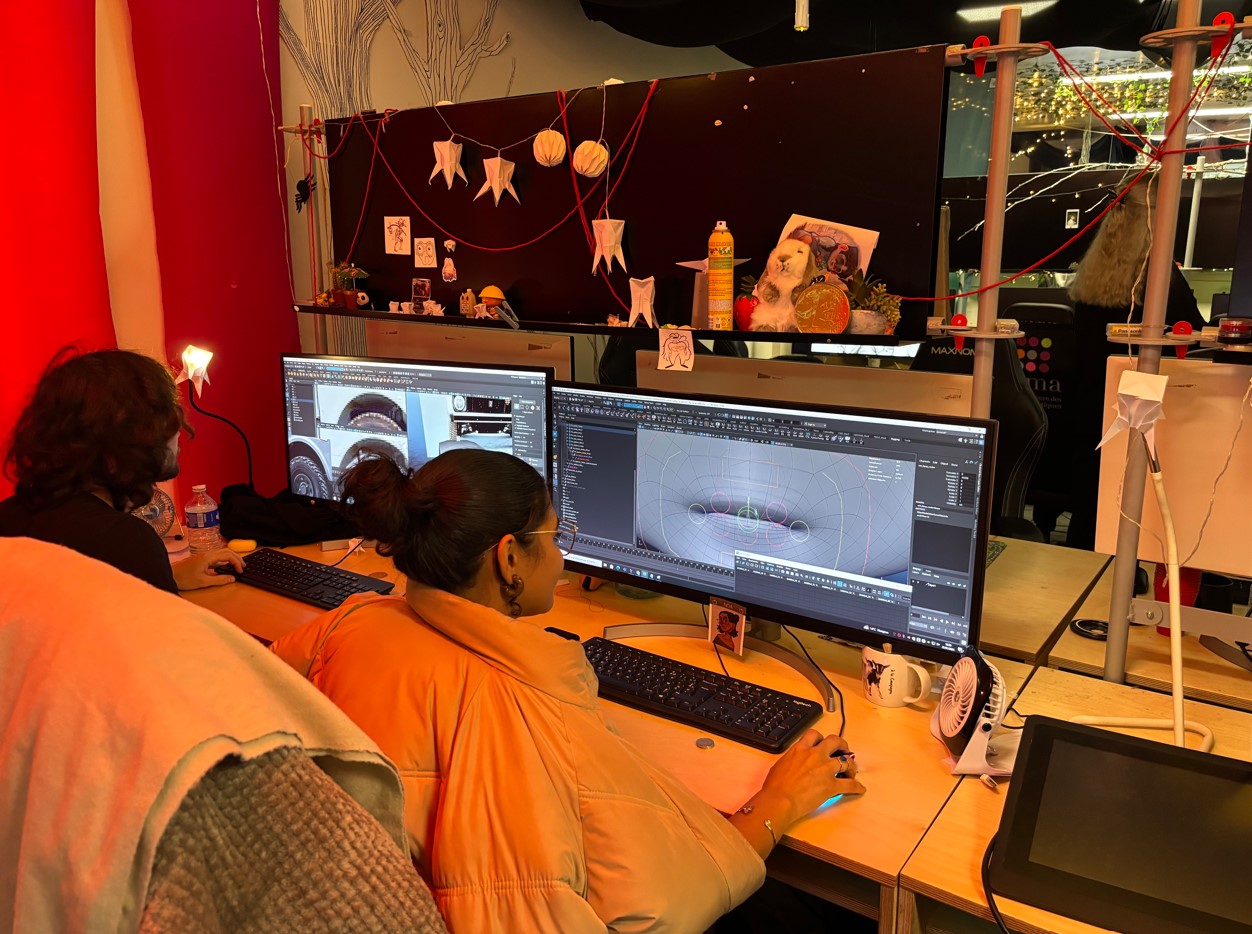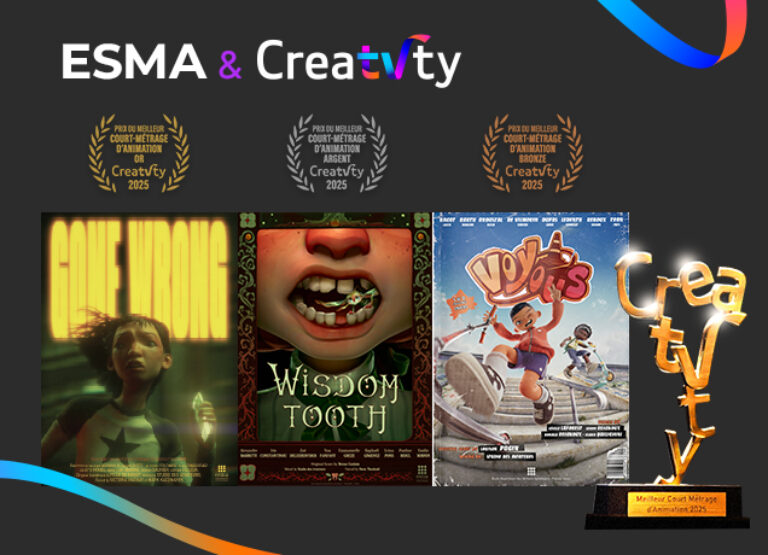
- Published 02.17.2025
- type Thematic news items
- Training 3D Animation & FX
Becoming a freelance 3D character animator is a rewarding career choice that offers artistic freedom and the chance to work on a variety of projects. However, this path requires solid technical skills, a well-developed business sense and the ability to stand out in a competitive market. Here are the secrets that ESMA teaches its students to succeed in this exciting field.
Setting up and running your own business
1. Defining your professional identity
As a freelance3D character animator, you are both the artist and the manager of your business. Defining your professional identity is crucial to attracting clients:
- Specialisation: Identify an area of expertise, such as character animation for video games, commercials or films. Similarly, some artists choose to focus on creatures, or humans. This will reinforce your credibility.
- Unique style: Develop an artistic signature that sets you apart from your competitors (realistic, cartoonish animation).
2. Planning and organisation
Setting up a freelance business requires rigorous organisation:
Legal creation: Register your activity as a freelance artist. Remember to adapt to the legislation in your country and that of your client: for example, the collective agreement for animation in France rules out the status of auto-entrepreneur/sole proprietorship, even though in practice some people opt for this. Conversely, working for the video game industry or for foreign clients does not involve the same constraints.
Financial management:
- Set your prices: Analyse market prices and calculate your costs (software, hardware, time, price/invoice). It’s essential not to undersell yourself: if you have talent and come from a school that is appreciated by the market, such as ESMA, your clients will know that your skills are valuable.
- Keep track of your income and expenses with dedicated tools, such as Wave. It is essential that you keep an eye on your accounts.
- Set aside an emergency fund for slack periods – you may not have clients all year round.
Production schedule: Draw up realistic schedules to deliver your projects on time while avoiding overwork.
3. Investment in professional tools
To produce quality work, you need the right tools:
- Software: Autodesk Maya, Blender, 3ds Max, or Cinema 4D depending on your needs.
- Hardware: A powerful computer with a high-performance graphics card, a screen calibrated for colour, and a graphics tablet.
- Resources: Invest in plugins or libraries of 3D models to speed up your work.
Networking and personal marketing
1. Building a professional network
Networking is essential for making yourself known and finding opportunities:
- Take part in events: Join conferences, festivals or workshops dedicated to 3D animation. For example, the Annecy Festival or SIGGRAPH.
- Join online communities: Forums such as Reddit; ArtStation, or LinkedIn groups are perfect for networking with other professionals.
Don’t underestimate the importance of recommendations: a satisfied customer can become your best ambassador.
2. Create a powerful online portfolio
Your portfolio is your business card. Here’s how to make it attractive:
- Quality before quantity: Showcase your best work, even if there isn’t much of it.
- Demonstrate your versatility or, conversely, your specialisation: Make a statement by adding animations of characters, objects and complex scenes, showing your experience. For ESMA students studying 3D Animation and Special Effects, it will be particularly interesting to showcase the production of the film made at the end of their studies, in order to highlight the different specialities used during the project, such as character animation, 3D modelling, rigging and lighting, for example. See all the short films made by our students in our student gallery.
- Include making-of videos: Showcase your work process to highlight your technical and creative skills. For example, the 3D animation film ‘Je suis un Caillou’, made by ESMA students (class of 2020), is accompanied by a making-of video they created to showcase their technical skills. You can watch it on our YouTube channel: Making of – Je suis un Caillou.
Platforms such as ArtStation, Behance or your own website can host your portfolio.
3. Personal marketing and branding
A strong online presence is crucial to attracting customers:
- Social networks: Share your creations on Instagram, X/Twitter, or LinkedIn to attract the attention of potential employers or partners.
- YouTube channel or Twitch: Post tutorials or live demonstrations to establish your expertise.
- Newsletter: Keep your customers and contacts informed about your latest projects and available services.
Don’t forget to use strategic keywords to improve your visibility on search engines.
However, be careful to respect NDAs (non-disclosure agreements): don’t share images unless you have the right to do so!
Independent projects
1. Finding clients
Freelance clients come from a variety of sources:
- Freelance platforms: Fiverr, Upwork, or Malt allow you to find a variety of assignments.
- Production studios: Approach studios by offering your services as an external contractor.
- Personal contacts: Use your network to get recommendations and projects.
Be proactive by contacting agencies or companies likely to need 3D animation.
2. Manage projects efficiently
Managing independent projects requires meticulous organisation:
- Precise brief: Make sure you fully understand the client’s expectations before you start.
- Regular communication: Keep the client informed of the project’s progress with frequent updates.
- Revisions: Plan milestones to receive interim feedback and adjust your work if necessary.
Use tools like Trello or Notion to organise your tasks and meet deadlines.
3. Build customer loyalty
Customer loyalty is essential to ensure a steady flow of projects:
- Respect deadlines: Always deliver your projects on time, even early if possible.
- Offer excellent customer service: Be responsive and professional in your dealings.
- Offer benefits: Offer discounts or extra services to regular customers.
4. Take on creative challenges
Independent projects offer a unique opportunity to explore bold new ideas. Don’t be afraid to experiment with innovative styles or techniques to impress your clients and enhance your portfolio.
Conclusion
Succeeding as a freelance 3D character animator requires a combination of technical skills, organisation and personal marketing. By creating a well-structured business, building a strong network, and delivering quality projects, you can build a successful freelance career. With dedication and a clear vision of your goals, you’ll be able to turn your passion for animation into a thriving and rewarding business. It’s a complex, uncertain and unstable path, but it offers a truly rewarding set of benefits.





